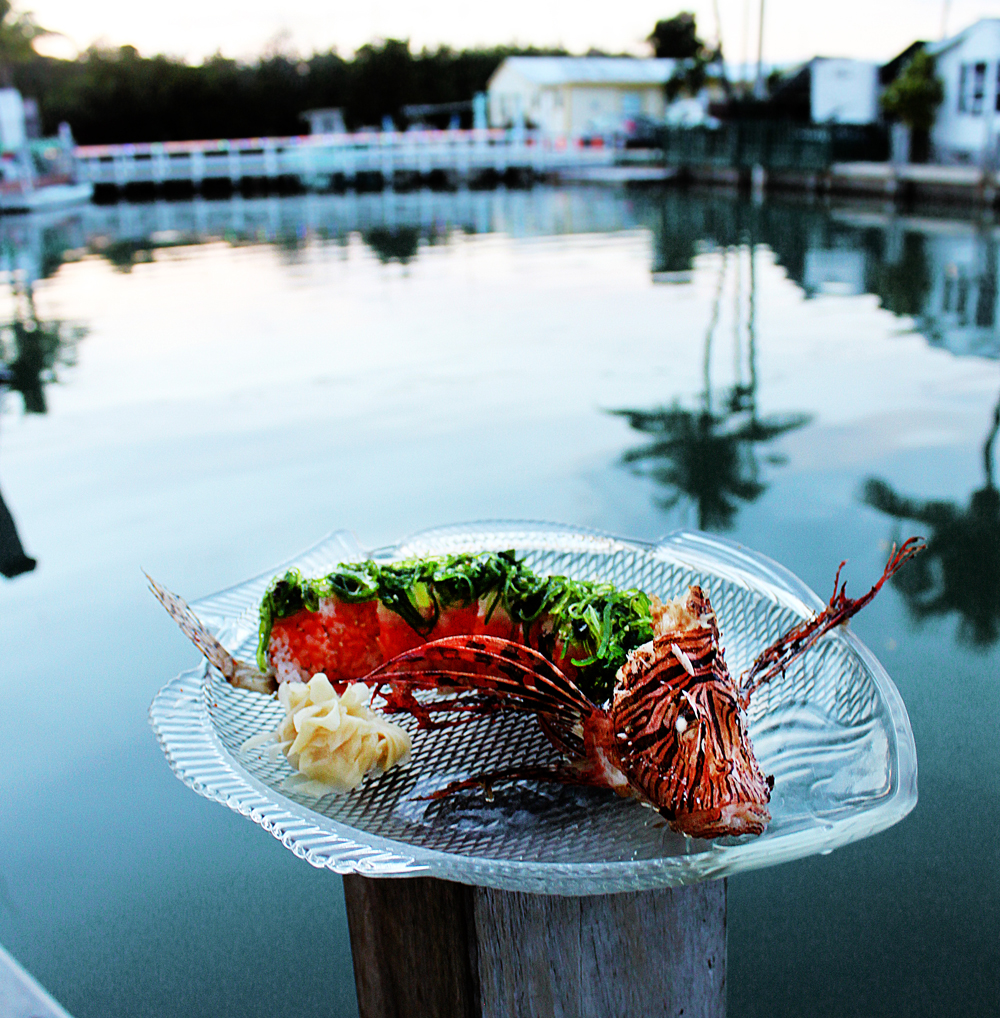It’s believed that lionfish, a popular Indo-Pacific aquarium fish, was first released in Florida’s Atlantic waters during the 1980s. Now lionfish prey voraciously on invertebrates and over 70 species of domestic fish. And these toothy coral reef fish, part of the scorpion fish family, have no natural reef predators except spearfishing humans.

Predatory lionfish are an invasive species with an exotic appearance — and a light, appealing taste.
However, a consumption revolution (sometimes referred to as “lionfish karma”) has begun in the Florida Keys, ensuring that the voracious eaters are being eaten.
Delicate and delicious, the light white meat of the lionfish tastes much like snapper. Its predator-deterrent venomous spines are removed before cooking, and the meat is perfectly safe — and very tasty — to eat.
Visiting divers and nondivers alike can make a real difference by ordering the fish at Keys restaurants as a cook-your-catch item or off the menu, helping to decrease lionfish populations and minimize their impacts. (FYI, Whole Foods grocery stores also sell the fish, whole or filleted, at their seafood counters.)
Fish House Encore Restaurant & Sushi Bar in Key Largo was the first restaurant in the Keys to begin serving lionfish, although it’s considered a special-request item and isn’t listed on the regular menu.

Lionfish is a special-request item at Key Largo’s Fish House Encore Restaurant & Sushi Bar. (Photo courtesy of the Fish House Encore)
At Castaway Waterfront Restaurant and Sushi Bar in Marathon, the owner himself dives for the lionfish he serves — making it a staple on the menu. Ask for it “wrecker” style (in a yummy sauce of capers, garlic, butter and diced tomato), as a sashimi (sliced fish) or nigiri sushi roll, or as a ceviche appetizer.
At Islamorada’s Marker 88 Waterfront Restaurant, owner/chef Bobby Stoky, also an avid lionfish diver, developed a recipe for butter baked lionfish that’s simple to prepare for the grill. Chefs simply line aluminum foil with carrot sticks, onion, zucchini, yellow squash, butter, salt and pepper. They then place lionfish fillets on top and grill the dish over high heat.
“It is a beautiful white meat,” Bobby said. “It is a great, simple-tasting fish. And what I mean by that is it does not have a fishy flavor at all.”
Other popular preparation methods include bacon-wrapping and barbecuing lionfish, poaching it or making it Bermuda style — the fillets encrusted with fried red onions and Japanese breadcrumbs, baked and served with a sweet-and-sour sauce atop baby arugula salad.
Key Largo–based Reef Environmental Education Foundation, widely recognized as a leading authority in lionfish research, removal practices and educational outreach, has adopted an “eat them to beat them” mantra. The Keys’ commercial fishing and restaurant communities are onboard too.
“Removing lionfish from local reefs is like weeding a garden: remove weeds and the garden is healthier; remove lionfish and the reefs are healthier,” explained Lad Akins, REEF’s founder. “The key is regular removals, year-round.”
REEF has even released “The Lionfish Cookbook,” designed to encourage the removal and consumption of the invasive predator. It features more than 60 appetizer and entrée recipes for preparing the mild-flavored fish.
Authored by Lad and personal chef Tricia Ferguson, with photography by David M. Stone, the cookbook also offers background information about lionfish biology and ecology, details on the species’ impacts, and tips on how to effectively and safely collect and handle lionfish. Earlier this year, it was nominated for three prestigious Gourmand World Cookbook Awards.
To purchase a cookbook, click here. And during your next trip to the Keys, make sure you try the island chain’s latest delicacy.


